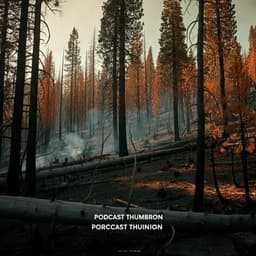
Environmental Studies and Forestry
Future transition from forests to shrublands and grasslands in the western United States is expected to reduce carbon storage
J. M. Kodero, B. S. Felzer, et al.
Discover how climate change is set to reshape the landscapes of the western United States, with significant shifts from forested regions to shrubland and grassland, resulting in substantial carbon loss. This crucial research by Jared M. Kodero, Benjamin S. Felzer, and Yuning Shi underscores the urgent need to address the impacts of climate change on our ecosystems.
~3 min • Beginner • English
Introduction
Forests in the western United States are projected to transition to shrubland or grassland, or be replaced by forest communities better adapted to fires and droughts in warmer climates. In recent decades, the region has experienced increases in drought intensity, fire frequency, and burn severity, largely driven by anthropogenic climate change and compounded by historical fire deficits that led to fuel accumulation. Paleoecological and historical studies (e.g., pollen records) show past climate changes produced vegetation shifts, with species-specific (individualistic) responses and sufficient time for dispersal under gradual warming. In contrast, current rapid warming, more frequent wildfires, and higher burn severity may outpace forest adaptation, creating climate–vegetation mismatches.
The authors posit that changes in dominant plant functional types (PFTs) will be driven by increased fires, persistent droughts, and warming, with outcomes dependent on PFT physiological tolerance, phenology, fire adaptation, and competitive dynamics. Forests not adapted to high-severity, stand-replacing fires may experience novel responses without historical precedent, as such fires can clear seed sources and allow grasses and shrubs to expand into areas previously dominated by trees. Future projections for the western United States indicate continued warming and altered precipitation patterns that intensify drought stress, particularly due to shifts from snow to rain and earlier snowmelt, reducing summer soil moisture and increasing vulnerability to severe fires. By the end of the century, a substantial fraction of landscapes are expected to have climates incompatible with current vegetation communities.
To address these questions, the study develops a new biogeography module based on BIOME4 and integrates it within an existing process-based biogeochemical model (TEM) to assess changes in dominant PFTs across forested regions of the western United States at 0.5° resolution. Dominance is determined by PFT competition based on total Net Primary Productivity (NPP). The study evaluates whether climate change under RCP 4.5 and RCP 8.5 will shift dominant PFTs by 2070–2100 and quantifies the implications for carbon stocks and fluxes.
Literature Review
Multiple lines of evidence indicate that climate change is altering vegetation and fire regimes in the western United States. Paleoecological records (e.g., pollen analyses) document historical vegetation shifts and species-specific range changes following the last glacial period under gradual warming, when plants had time to disperse. Contemporary changes include increased drought intensity, higher fire frequency, and greater burn severity, largely attributed to anthropogenic warming and exacerbated by historical fire suppression that increased fuel loads. While fire historically mediated climate–vegetation responses by selecting for fire-adapted species, these adaptations often correspond to mild-to-moderate regimes; forests not adapted to high-severity, stand-replacing fires may respond unpredictably as seed sources are removed and grasses or shrubs expand.
Modeling studies have variously projected complete transitions from forests to shrublands/grasslands in some regions or shifts among forest species in others. A large share of future western U.S. landscapes is projected to have climates incompatible with current vegetation communities by century’s end. Additional work highlights moisture thresholds along the Sierra Nevada beyond which forests may shift to shrublands/grasslands in warmer, drier conditions, and increased risk of cheatgrass invasion under climate-induced decreases in soil moisture, with up to a 45% increase in suitable invasion area in parts of the interior West. Observational and modeling studies (e.g., LTER and flux tower networks) have reported regional variations and trends in NEP and declines in carbon storage associated with drought and land-use change, although future drought extremes may lack historical analogs. Collectively, the literature underscores the strong roles of warming, moisture stress, and fire in driving vegetation transitions and altering carbon dynamics.
Methodology
Model framework: The Terrestrial Ecosystem Model (TEM) is a process-based biogeochemical model that simulates carbon, nitrogen, and water fluxes among the atmosphere, vegetation, and soils, including photosynthesis (GPP), respiration, allocation, litterfall, nitrogen uptake, and dissolved organic carbon dynamics. TEM includes multiple structural pools for vegetation carbon and nitrogen, and single pools for soil organic carbon and nitrogen and soil inorganic nitrogen. A seed pool is included; during allocation, a PFT-dependent fraction from the labile pool (replenished by GPP) can be allocated to seeds when labile carbon exceeds structural storage capacity.
Biogeography module: A new module based on BIOME4 defines potential PFTs per grid cell using bioclimatic envelopes: thresholds for mean temperature of the coldest and warmest months, minimum annual precipitation, and a moisture stress metric (AET, the ratio of actual to potential evapotranspiration computed with Penman–Monteith). Minimum envelope thresholds were estimated from historical simulations (CRU 4.5, 1900–2014), using the 5th percentile during summer months when moisture stress peaks. AET ranges from 1 (no stress) to 0 (wilting), with categories for low to severe water stress. For each grid cell, the dominant PFT is selected as the one with the highest total NPP (above and belowground) over the preceding 30-year period and assigned 100% areal coverage. Validation for biogeography is based on correctly determining dominant PFTs during 1984–2014.
Fire module: Fire processes are adapted from the Community Land Model (CLM) 5.0, including fuel availability (from biomass), ignition (natural and anthropogenic), combustibility (from relative humidity and soil moisture), fire spread (wind speed and PFT-specific spread rates), and suppression (population density). Burned area and severity depend on climate, PFT composition, and human activity. Combustion completeness factors for leaves and stems follow CLM. For historical fires (1750–2014), LANDFIRE fire return intervals (FRI) govern frequency, with modifications reflecting fire suppression/deficit (~1800s–1980) to better match historical regimes; CLM retains control over occurrence/severity based on climate and ignition. Apart from these historical adjustments, the fire module matches CLM’s non-peat fire implementation.
Study domain and resolution: Simulations focus on forested grids in the western United States at 0.5° × 0.5° resolution. Each grid begins with a single dominant PFT, except mixed temperate forests which include temperate conifer and deciduous PFTs. Grasses and shrubs are present in most grids; where absent, the model assumes grass and shrub seed sources are available.
Scenarios and runs: Two historical runs (with and without historical fire) were conducted from dynamic equilibrium (no fire) through 1750–2014. Final states from both serve as initial conditions for future runs (2015–2100). For each scenario (RCP 4.5 and RCP 8.5), 20 future runs were performed using MACA-downscaled CMIP5 GCMs. Outputs across the 20 models were aggregated as multi-model means with standard deviations. A PFT is considered dominant if more than 10 of the 20 models agree.
Climate and ancillary data: Historical climate (1750–1900) from MPI-ESM-P and (1900–2014) from CRU 4.5 were bias-corrected using gridMET (1979–2014 overlap) with delta (temperature) and ratio (other variables) adjustments to align historical with future MACA datasets. MPI was bias-corrected similarly, and all datasets were regridded to 0.5° (nearest-neighbor downscaling; averaging for upscaling). Future climates (2015–2100) use MACA-downscaled CMIP5 RCP 4.5 and 8.5 ensembles. Additional inputs include solar radiation, vapor pressure, wind speed, CO2, O3, nitrogen deposition, static soil texture, and elevation. Land use and land cover datasets inform potential land cover; simulations focus on forested grids.
Carbon accounting: NPP is calculated as GPP minus autotrophic respiration; NEP is NPP minus heterotrophic respiration (rh) and direct volatilization from decomposing standing dead (VOLAC). Net Carbon Exchange (NCE) equals NEP minus burned carbon (E). Conversion fluxes related to human land use (e.g., decay of agricultural/wood products) are excluded; with land-use conversions not simulated, modeled NCE is equivalent to Net Biome Productivity. Carbon stocks (vegetation carbon, soil organic carbon) and fluxes (NPP, NEP, NCE) are compared between historical (1984–2014) and end-century (2070–2100). Principal component analyses relate PFT shifts to moisture stress, fire, temperature, and precipitation.
Key Findings
- Large shifts in dominant PFTs from forests to non-forest types by 2070–2100:
• RCP 4.5: 40% of historically tree-dominated grids transition (shrubs 7%, grass 32%).
• RCP 8.5: 58% transition (shrubs 18%, grass 40%).
- Geographic patterns: Forest-to-grassland shifts are most pronounced in the Northern Rockies and Puget Trough; forest-to-shrubland transitions dominate in the Southwest. Boreal and temperate conifer forests exhibit upslope shifts in mean elevation under both scenarios.
- Drivers of shifts (PCA loadings of variance contributions):
• RCP 4.5: moisture stress 55%, fires 27%, temperature 13%, total precipitation 6%.
• RCP 8.5: moisture stress 53%, fires 26%, temperature 14%, total precipitation 7%.
- Carbon stocks and productivity decline with forest loss:
• Decreases in total NPP, vegetation carbon (VEGC), and soil organic carbon (SOC) by 2070–2100 relative to 1984–2014 in both scenarios, driven by more severe fires and unfavorable climate facilitating grass/shrub expansion at the expense of trees.
• NEP increases: up to +0.2 PgC per 30 years (RCP 4.5) and +0.5 PgC per 30 years (RCP 8.5), reflecting expanded grass/shrub dominance under warmer, drier conditions.
• Net carbon balance (cumulative NCE) shows regional net losses: −60 GgC (RCP 4.5) and −82 GgC (RCP 8.5) by century’s end; temperate coniferous forests contribute most to losses.
- Fire–climate interactions: Warming enhances drought, which increases fire severity and frequency, clearing tree PFTs and enabling grass/shrub establishment. In hotter, drier, grass-dominant grids, fires occur more frequently.
- Historical vs. future: No difference in end-century dominant PFT changes was found whether historical fire was included or excluded in the historical run initialization.
Discussion
The projected transitions from tree-dominated PFTs to shrub and grass PFTs across the western United States are primarily driven by increased drought severity, higher temperatures, and more frequent and severe fires. Snow-to-rain shifts and earlier snowmelt reduce summer soil moisture, exacerbating moisture stress and fire vulnerability. These changes diminish the region’s capacity for long-term carbon storage because forests store more carbon than shrublands or grasslands. Although NEP increases under both scenarios—largely due to the productivity of expanding grass and shrub PFTs—this enhancement does not compensate for the declines in vegetation and soil carbon pools associated with forest loss, leading to net carbon losses (negative NCE). Elevational and range shifts suggest forests may persist in cooler, wetter refugia, but suitable habitat for high-carbon-storage tree PFTs could narrow. Fire acts as both a catalyst and facilitator of PFT turnover by removing biomass and seed sources, accelerating range shifts in climate–vegetation mismatch zones. Post-fire regeneration is further constrained by moisture stress, limited seed availability, burn severity, repeated disturbances, topography, and competition from shrubs and grasses, raising the likelihood of transitions to persistent non-forest states in some landscapes. The findings align broadly with other studies that identify moisture thresholds for forest persistence and increased susceptibility to invasive grasses under drying climates. Overall, the results underscore the central role of coupled fire–drought–warming processes in reconfiguring vegetation and carbon dynamics in the region.
Conclusion
By integrating a BIOME4-based biogeography module with a process-based ecosystem model (TEM), this study projects substantial shifts from forest to shrubland and grassland across the western United States by 2070–2100 under RCP 4.5 and 8.5, with concomitant declines in vegetation and soil carbon stocks and net regional carbon losses, despite increases in NEP. Moisture stress and fire emerge as dominant drivers of change, with notable upslope shifts in coniferous forests and strong geographic patterns of forest conversion. These results highlight the need for proactive adaptation and mitigation strategies, including fuel reduction treatments, prescribed burning, strategic fire breaks, climate-adapted reforestation, and targeted management of transitioning shrubland and grassland systems to sustain ecosystem services and carbon sequestration. Continued research is needed to refine projections, improve representation of post-fire regeneration processes and seed dispersal, and support effective, regionally tailored management under ongoing climate change.
Limitations
- Species-level processes are not represented; the model operates at the PFT level and assumes dominant PFT occupies 100% of a grid cell, which may oversimplify mixed stands and transitional mosaics.
- Seed sources and dispersal are not explicitly modeled; the model assumes tree, grass, and shrub seeds are available everywhere following fires, potentially overestimating post-disturbance establishment.
- Fire module complexity is constrained by grid scale and CLM-based parameterizations; while historical fire frequency is guided by LANDFIRE FRI with suppression-era adjustments, fine-scale ecological dynamics and management histories are not fully captured.
- Carbon accounting excludes conversion fluxes associated with human land use (e.g., decay of agricultural and wood products); NCE is treated as equivalent to Net Biome Productivity under the study’s assumptions.
- Bias corrections, downscaling/upscaling, and multi-model averaging introduce uncertainties not fully characterized beyond mean and standard deviation; individual model distributions and structural uncertainties are not explicitly resolved.
- The model is calibrated and evaluated at 0.5° resolution, which may not capture local heterogeneity in climate, topography, and disturbance regimes.
- Validation focuses on dominant PFTs (1984–2014); lack of species-level validation may limit inference on intra-forest compositional shifts.
Related Publications
Explore these studies to deepen your understanding of the subject.







